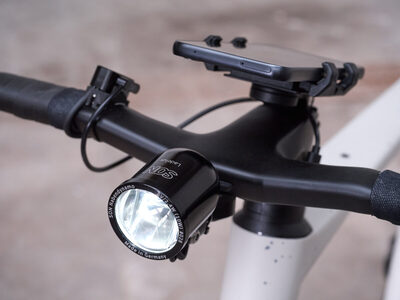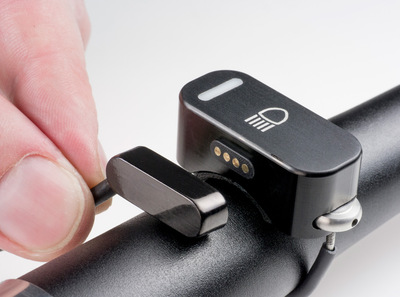

See their webpage here.
| [ Main index » Bicycle components tests » (Dynamo) bicycle lighting » Headlamps with cutoff for dynamo » Schmidt Ladelux dynamo lighting system with USB power output | ] |
Pictures from Schmidt:


See their webpage here.
Page created 2025-6-22. Last updated 2025-7-2. I have not tested the Ladelux but I think it is interesting in some aspects to compare especially with the Igaro C1 so I will go over some issues and specifications. What I don't think I will like, should I ever test one, is the beam pattern (uneven and strongly visible patterns). An even beam is important especially on bad roads because only then do you know whether what you see is caused by the road instead of by the beam. Riding with an uneven beam on bad roads is mentally draining because you need to analyse all the time as far as is possible then, what is the best place to ride to evade holes and bumps. With an even beam I mean that the intensity does not vary much, especially in areas close to each other. This implies that there are few artefacts and that they don't stand out, as artefacts are patterns with brightness differences that stand out, which means a strong difference in intensity in areas close to each other... A gradual drop off in intensity to the sides and to far away is normal, and such a drop off to the sides is also good. A sharp cutoff to the sides can lead to psychological effects such as feeling trapped in a tunnel of light. See my analysis and my overview section on bicycle lighting for more on this.
I've uploaded a video about the Ladelux (2025-6-23), with some comparisons with the Igaro C1 which is the nearest competitor. I will add a link later to the video. Here is the summary, with some extra details:
The announcement is from 16 May 2025 but strangely they state on the Ladelux page (https://nabendynamo.de/en/products/headlights/ladelux/) that it has been available since November/December 2024... :
Ab Dezember 2024 kann der Ladelux-Scheinwerfer exklusiv in unseren Ladelux Partner Stores vor Ort gekauft werden. Ab November sind bereits Vorführmodelle in den Läden zu sehen. Wir werden das Ladelux-Netzwerk nach und nach weiter ausbauen.
Some of my thoughts:
The beam is most important, that looks like a total fail...
Question: What would the cost be to replace the battery? You will need to send the light to Schmidt or one of those 'Ladelux stores'...
I sent Schmidt an email about this issue on 2025-6-24: How long do they expect the battery to last and what will it cost to get it replaced?
More thoughts to come, but I will probably not do a proper review with USB output measurements etc. as I don't want to spend that much money if the beam isn't great, which it isn't from what I saw on youtube.
The emphasis (bold) below, was in the original reply:
The Li-Ion battery inside the Ladelux is not intended as a primary power source but serves purely as a buffer. It compensates for short-term dips in power supply – for example, when stopped at a traffic light or riding slowly with both the high beam and a USB device in use. So the concern that the battery may quickly deplete during frequent USB charging or high beam use is generally not an issue in real-world use.
Typical Use on Tours or Day-to-Day:
- USB charging is fully supported with a SON28 hub at speeds above approx. 18 km/h.
- High beam can remain continuously on from around 22 km/h.
- At lower speeds, the buffer battery kicks in to maintain these functions.
- If the battery drops below approx. 33%, the high beam and USB charging are automatically deactivated to preserve core lighting functions.
Dipped beam and taillight always remain operational – even at very low speeds or when stationary – as their intensity adapts dynamically to the available power. High beam and USB charging are added only when there's sufficient energy from the hub or buffer battery.
Battery Longevity:
The battery is used in a way that minimizes wear:
- It is never fully charged or discharged – only approx. 33% to 80% of its capacity is used.
- The electronics try to maintain it at an optimal charge level.
- This significantly reduces the typical aging seen in devices with daily full charge cycles (like smartphones).
In practice, several Ladelux units have been in daily use for over two years – without any noticeable loss in capacity. Even as the battery ages, it does not affect the device’s core functionality, as it only serves as a buffer.
Based on our experience and the way the battery is managed, we estimate a battery lifespan of 5 to 10 years, depending on usage patterns. In scenarios like long-distance touring with average speeds of 15–20 km/h and continuous USB charging, we would actually expect closer to 10 years of service life, due to the relatively low demand placed on the battery in such conditions.
Battery Replacement:
The battery is not user-replaceable – similar to the Edelux – but we do offer a paid battery replacement service. Details on this will soon be available on our website as part of a comprehensive FAQ section, which we’re currently working on.
Some comments about this to come later.
I received a prompt reply on 2025-7-1, about battery charging current and battery temperature.
Reply to my criticism about the reflector (from B&M):
We decided to use the reflector from the Edelux in order to reduce development effort. Half of our development team was fully occupied with the Ladelux project for over two years. I can’t promise that we’ll offer a custom reflector in the future – but it’s definitely something I would love to see happen.
I then mentioned charging at low temperatures, here the Igaro C1 is at an advantage (full charge speed), besides the issue that a supercap has much lower storage capacity:
The Ladelux remains fully functional even at ambient temperatures well below freezing. When the battery temperature is still below 0 °C at the start of a ride, the system limits the charging current to a maximum of 100 mA as a precaution, in order to avoid unintended discharge due to measurement inaccuracies. Li-ion batteries can be discharged down to -20 °C – as you rightly pointed out, this means both high beam and USB charging remain available, provided that the dynamo can supply the required power or the battery still holds sufficient charge. As usual, the dynamo output is regulated to match the system’s power demand as closely as possible. In practice, the headlight begins to warm up noticeably within the first few minutes of riding – but only when power is actually being drawn from the dynamo, such as when the light is on or USB charging is active. During our winter stress tests at -10 °C ambient temperature, the battery typically reached positiv temperatures after 5–10 minutes of operation, depending on the dynamo load. These results were incorporated into the fine-tuning of the system for cold-weather performance. If we’ve done our job right, you shouldn’t notice any difference in functionality at sub-zero temperatures compared to normal conditions.
I wondered whether the battery could be charged at a rate that affects the capacity (fast charging is not good for batteries):
We have full control over the dynamo’s power output and can dynamically adjust it to match the system’s current requirements. When no consumers are active (i.e., no lighting or USB load), the battery is charged using the standard CC/CV method for Li-ion batteries, with a maximum current of 1 A, up to a target charge level of 80%. Once this level is reached, the dynamo is put into idle mode.
And I asked about charging limitations, whether heat could affect the charging when it is hot, and what would happen, similar to smart phones. Especially a smart phone used for navigation in direct sunlight gets really hot! The phone then limits charge speed just like it does when the battery is at a temperature below 0 C:
Smartphones have a relatively high power density, which makes them more prone to heat buildup. In contrast, the Ladelux has a black housing, but its rounded shape helps minimize heat absorption from direct sunlight. We have, of course, also conducted extensive tests under these conditions. The headlight was operated for several hours at full power on the test bench without any airflow. If the battery ever does get too hot, the system automatically reduces the charging current and disables the additional features – similar to how it behaves in cold conditions.
The answers are all very useful, and it seems like they considered all issues, but we will see what happens in practice with more users besides those who used the prototype during development.
| To email me go to the email page |
Last modified: 2025-7-2